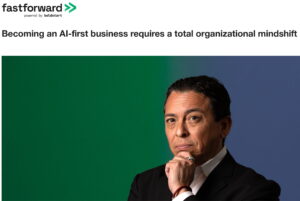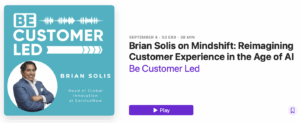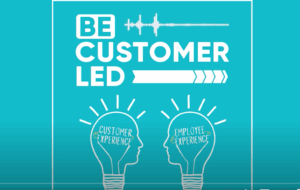Last year, I spent time with Mark Johnson, CEO and CMO of Loyalty360, to discuss all things Customer Experience (CX). The conversation was so rich, it resulted into a two-part series exclusively for the Loyalty360 community. Now however, I’ve been given the green light to share the conversation (parts 1 and 2) with you here.
Part 1 – This is the Year of Customer Experience
If you ask 100 executives what customer experience means to them, you would likely get 100 different answers. The need to define CX is compounded by the fact that modern customers expect the very best customer experience from their favorite brands, but not even these shoppers are sure what exactly that experience might entail.
In his literary works, including the latest X: Where Business Meets Design, Altimeter Group’s Principal Analyst Brian Solis examines what constitutes the core of customer experience, and how companies can make a cultural shift to become more customer-centric. Loyalty360 sat down with Solis to discuss his findings.
Mark Johnson, Loyalty360: There’s been discussion in recent years about what exactly customer experience means, how it can be achieved, and what kind of impact can it have on businesses. In your mind, how can we define customer experience?
Solis: The whole concept of customer experience, even down to its basic definition, has been essentially up for interpretation. The interesting thing is that we see perspectives on CX change based on the problem being fixed.
I think in order to truly define customer experience, we need to embrace the fact that customers are different now than previous generation. Because of the prevalence of digital media in their lives, they’ve completely upended the customer journey as we know it. What was once a continuous journey through the shopping experience is now a series of micro-moments.
In other words, to define CX we need to reframe the conversation to face challenges in a way that’s innovative rather than iterative.
The marketing paradigm has traditionally been very top-down and autocratic in the past; do you see changing this paradigm as a real challenge for marketers?
Solis: There needs to be a fundamental change in the structure of people who work on CX within an organization. Some of it can be summed up in a favorite joke of mine: “I tried to be creative, but I ended up stuck in meetings all day.”
In most cases, customer experience is driven by separate departments; they’re not collaborating with one another and by default, they’re contributing to a disjointed customer experience. While each group may be striving to do its best, CX is measured by the sum of its parts. Without collaboration, it can never be truly connected and holistic. Customers don’t see departments, they see an individual brand. That is so important as a marketer, and that’s why we’re seeing so much disruption now as companies like Amazon and Uber provide customer experience in ways we’ve never seen before.
What are some of the challenges you see with these disparate data sources, and being able to piece together these valuable data points?
Solis: As in anything, I think the biggest challenge is looking at how the organization thinks about the customer today, and finding friction points on which to focus data sets. I would use these friction points to spark discussions about who is steering the company’s customer experience efforts.
Most friction points fall within a grey area of responsibility. They occur when an issue falls into a space not completely covered by team responsibilities. I see this creating an opportunity for a new role within organizations that serves as a lynchpin for all experience-related concerns.
We often hear terms like “corporate commitment” and “organizational buy-in” when it comes to creating a customer-centric culture within a company. What have you seen in terms of these challenges?
Solis: In the past several years, I’ve really begun to start taking a hard look at culture. The reason for that is because I see innovation in pockets rather than a way of business and ask why companies are more innovative than others, and the answer often comes down to culture. Culture, like CX, is often hard to define, but what I see over and over again is that important cultural pillars such as employee engagement and leadership are not receiving enough attention or investment from the company.
Culture is massive, but what I’ve also learned is that if you’re waiting for someone to come along and tell you how to change or improve culture or anything, you’re on the wrong side of innovation. If, however, you think you can take it on and create real impact from within, even though it’s not your job, then you’re the right person for the job; change can come from anywhere in the company, from any level of the organization.
A lot of companies may think that they’re affecting culture and impacting employees in a positive way, but actually aren’t. How do you think these brands can pinpoint where they are in terms of culture and employee engagement?
Solis: Many executives simply don’t want or know to prioritize have the culture conversation. Most leaders want everything tied to performance, because that’s a tangible metric they can use for comparison, but it’s a rare gift when they peel back layers to get to the core of why things are (or aren’t) happening. If morale is low, the question becomes: how can we talk about innovation if we can’t take care of the culture and the people responsible for it?
I call this “the engagement gap.” When I’ve studied culture, I cast a company-wide survey about employee engagement practices. What I’ve found is that there’s a significant gap between where executives think employee engagement is, and where it is in reality. It’s a big eye-opener for companies that are investing in things like technology, journey mapping, and digital transformation, but aren’t thinking enough about the employee experience and getting people onboard and engaged to be genuine, empowered brand ambassadors.
We sometimes hear companies talk in buzzwords and acronyms, without necessarily showing that they fully understand the impact behind them, how have you observed this trend in your studies?
Without saying anything negative about things like NPS, CSAT, etc., I will say this: I’ve definitely seen executives set goals based on these metrics simply because increasing these measurements look good to shareholders and stakeholders. They do this, however, without a complete understanding of today’s customer. With how connected we are becoming and how the journey, behavior, expectations, values, etc. are changing, the NPS could evolve from “Would you recommend us?” to “Did you recommend us?” The proliferation of social sharing or just the publishing of experiences online is changing the marketing landscape, and companies need to change the way they look at metrics and what it means to the new customer journey.
The reason that innovation is difficult is because we tend to look at the future wearing a lens colored with the past. If I walked into a room of executives and had a conversation about what customers like about the company, what they don’t like about the company, and how the company can drive millions of dollars of new revenue, I don’t think a single one would say no to that kind of information. The problem is that to get to that conversation, you need to wade through a mire of politics and risk aversion in order to let go of the way things are and were.
It’s time to move forward.
Continue on to Part 2…
Please read X, The Experience When Business Meets Design or visit my previous publications
Connect with Brian!
Twitter: @briansolis
Facebook: TheBrianSolis
LinkedIn: BrianSolis
Youtube: BrianSolisTV
Snapchat: BrianSolis
Invite him to speak at your next event or meeting.
About Mark Johnson
Mark is CEO & CMO of Loyalty360. He has significant experience in selling, designing and administering prepaid, loyalty/CRM programs, as well as data-driven marketing communication programs.
Photo Credit: FastCoDesign







As always, love your insights. Thanks for sharing and Happy New Year!